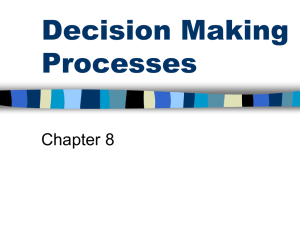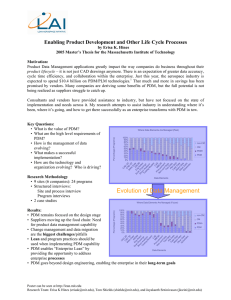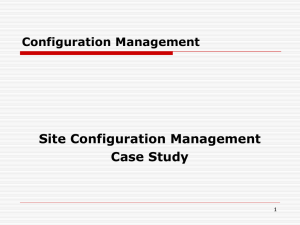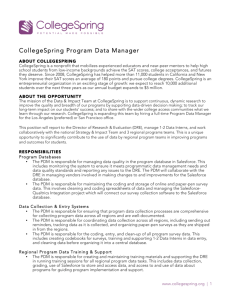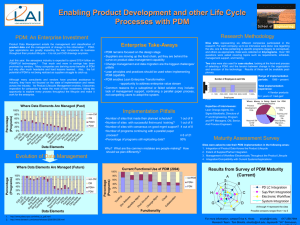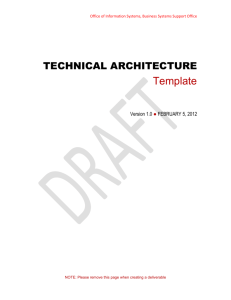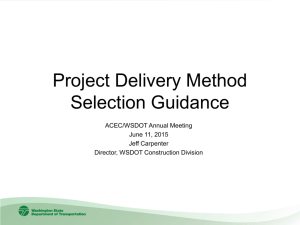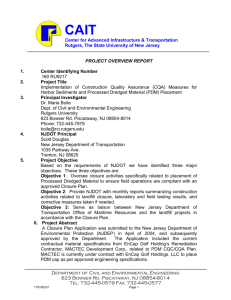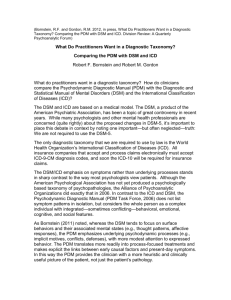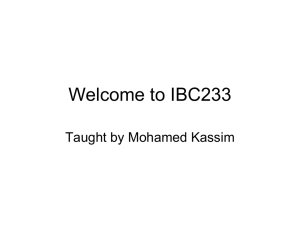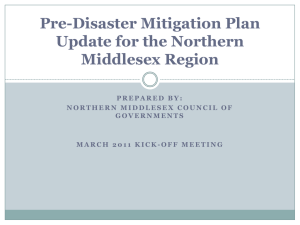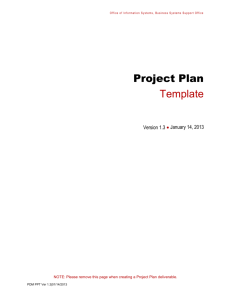Constraints, Limitations, Assumptions and
advertisement
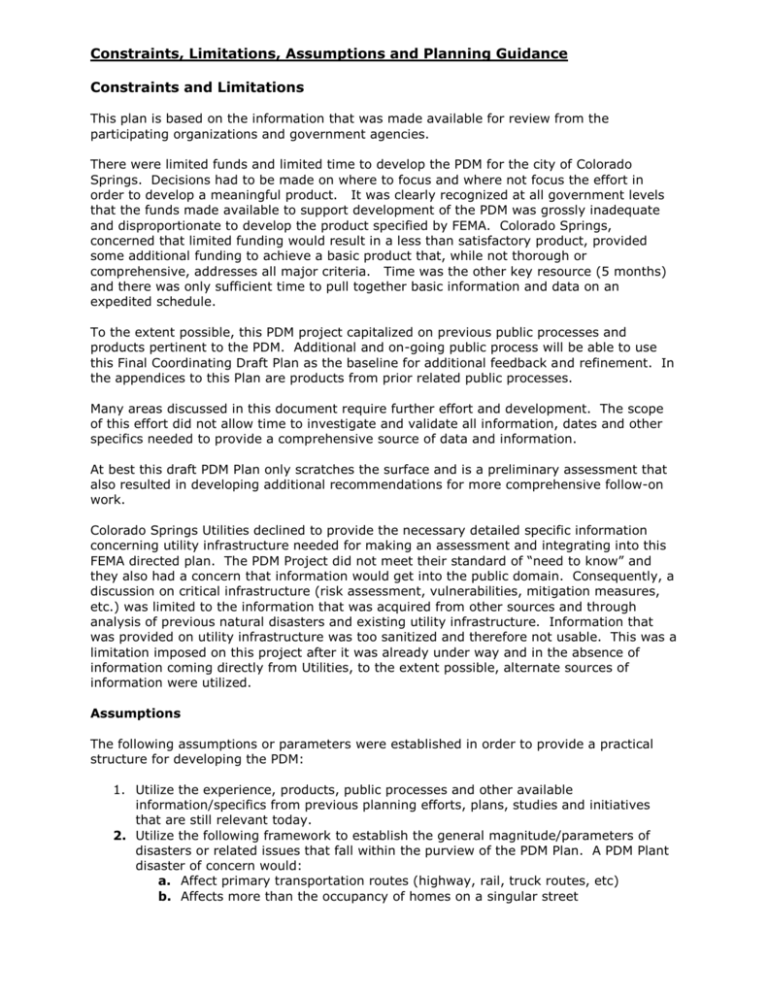
Constraints, Limitations, Assumptions and Planning Guidance Constraints and Limitations This plan is based on the information that was made available for review from the participating organizations and government agencies. There were limited funds and limited time to develop the PDM for the city of Colorado Springs. Decisions had to be made on where to focus and where not focus the effort in order to develop a meaningful product. It was clearly recognized at all government levels that the funds made available to support development of the PDM was grossly inadequate and disproportionate to develop the product specified by FEMA. Colorado Springs, concerned that limited funding would result in a less than satisfactory product, provided some additional funding to achieve a basic product that, while not thorough or comprehensive, addresses all major criteria. Time was the other key resource (5 months) and there was only sufficient time to pull together basic information and data on an expedited schedule. To the extent possible, this PDM project capitalized on previous public processes and products pertinent to the PDM. Additional and on-going public process will be able to use this Final Coordinating Draft Plan as the baseline for additional feedback and refinement. In the appendices to this Plan are products from prior related public processes. Many areas discussed in this document require further effort and development. The scope of this effort did not allow time to investigate and validate all information, dates and other specifics needed to provide a comprehensive source of data and information. At best this draft PDM Plan only scratches the surface and is a preliminary assessment that also resulted in developing additional recommendations for more comprehensive follow-on work. Colorado Springs Utilities declined to provide the necessary detailed specific information concerning utility infrastructure needed for making an assessment and integrating into this FEMA directed plan. The PDM Project did not meet their standard of “need to know” and they also had a concern that information would get into the public domain. Consequently, a discussion on critical infrastructure (risk assessment, vulnerabilities, mitigation measures, etc.) was limited to the information that was acquired from other sources and through analysis of previous natural disasters and existing utility infrastructure. Information that was provided on utility infrastructure was too sanitized and therefore not usable. This was a limitation imposed on this project after it was already under way and in the absence of information coming directly from Utilities, to the extent possible, alternate sources of information were utilized. Assumptions The following assumptions or parameters were established in order to provide a practical structure for developing the PDM: 1. Utilize the experience, products, public processes and other available information/specifics from previous planning efforts, plans, studies and initiatives that are still relevant today. 2. Utilize the following framework to establish the general magnitude/parameters of disasters or related issues that fall within the purview of the PDM Plan. A PDM Plant disaster of concern would: a. Affect primary transportation routes (highway, rail, truck routes, etc) b. Affects more than the occupancy of homes on a singular street c. Affects critical facilities/infrastructure such as a hospital, power plant, water treatment plant, waste water treatment plants, primary utility distribution or collection systems or other critical buildings and infrastructure d. Threatens public health, public safety, public welfare and or is a life safety issue e. Affects more businesses than on one singular street 3. The PDM Plan addresses root causes of disasters by establishing or emphasizing mitigation and planning requirements that guide or regulate development 4. The activity/project is validated by an external agency in a formal assessment and or the proposed activity/project can be correlated directly to the criteria used on an external validation by a similar activity/project. a. Examples include designated disaster landslide areas being reviewed by the Colorado Geological Survey, flood studies by the Corps of Engineers and so forth. b. This may involve external agencies recognizing/validating that additional problem areas require further study Planning Guidance The Pre-Disaster Mitigation (PDM) Plan creates a blueprint for reducing the City’s risk and vulnerability due to natural hazards. The PDM Plan in conjunction with other similar plans, programs, policies, ordinances, etc. is a guide: 1. For decision makers 2. For allocation and prioritization of resources 3. To establish a long-term vision and strategy Integrate the planning processes, visions, long-term goals and objectives of various organizational and regional elements to promote a reduction in Colorado Springs’ exposure to future natural disasters. This includes the functional areas of planning, public works, floodplain administration, transportation, emergency management/services, public safety, utilities and other governmental agencies and other stakeholders. Elements of the PDM Plan are usable for other disasters (man-made and natural). Activities or projects that are proposed for federal funding are in one sense a national priority (maybe a low national priority but federal funding has some relevance to a national priority). Federal funding requires visibility at all levels in order to leverage this asset and ensure the city is a good steward of U.S. taxpayer’s dollars. As time permits document existing on-going processes, procedures and initiatives that support the intent the PDM Plan as well as related activities and projects. Capitalize on and utilize previous efforts, studies, reports, etc. that have previously addressed topics and functional areas within the Scope of the PDM. The PDM Plan is not a comprehensive encyclopedia of all disasters that have affected Colorado Springs or a summary of all initiatives and actions that are related to disaster preparedness, mitigation, response and recovery. The PDM Plan is a strategic Plan that identifies the continued threat of natural disasters and a strategy (which includes goals and objectives) to address these threats as well as maintain the PDM as a living relevant Plan. The PDM Plan should lend itself to having the Mitigation Strategy, Goals, Objectives, Activities and Projects (Loss Reduction Activities) and Plan maintenance requirements updated relatively easy. The PDM Plan will reference some but not all related studies, reports, etc. The ones selected or referenced are representative of other documents and works that may also exist. Office of Emergency Management For Public Comment: mailto:SDubay@springsgov.com 719-385-7229
